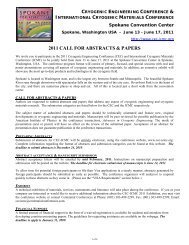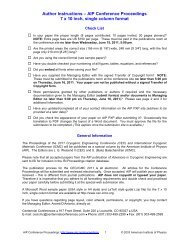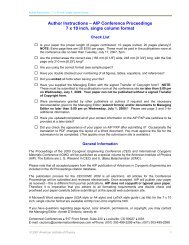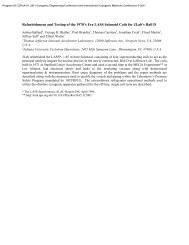CEC Abstracts in PDF format (as of 7/3/07) - CEC-ICMC 2013
CEC Abstracts in PDF format (as of 7/3/07) - CEC-ICMC 2013
CEC Abstracts in PDF format (as of 7/3/07) - CEC-ICMC 2013
You also want an ePaper? Increase the reach of your titles
YUMPU automatically turns print PDFs into web optimized ePapers that Google loves.
<strong>CEC</strong> 20<strong>07</strong> - <strong>Abstracts</strong><br />
C1-M-10 Development <strong>of</strong> a Cryogenic Gate Valve with<br />
Robust Seal<strong>in</strong>g<br />
W.H. Hatfield, Sierra Lobo, Inc.; J.P. S<strong>as</strong>s, NASA<br />
KSC.<br />
A s<strong>of</strong>t-seat cryogenic gate valve h<strong>as</strong> been designed, fabricated, and<br />
demonstrated by the Cryogenics Test Laboratory at the Kennedy<br />
Space Center (KSC), featur<strong>in</strong>g a robust seal<strong>in</strong>g technology and a high<br />
Cv flow characteristic. The robust seat design <strong>in</strong>corporates a novel<br />
retract<strong>in</strong>g seat-reta<strong>in</strong><strong>in</strong>g disk to prevent s<strong>of</strong>t-seat abr<strong>as</strong>ive wear and<br />
damage on the valve body hard seat. Advanced materials were<br />
<strong>in</strong>corporated <strong>in</strong>to the design, <strong>in</strong>clud<strong>in</strong>g porous sponge<br />
polytetrafluoroethylene (PTFE) for the seat material and titanium<br />
nitride coat<strong>in</strong>g for the 316 sta<strong>in</strong>less-steel surfaces that are subject to<br />
wear<strong>in</strong>g or gall<strong>in</strong>g. The valve is suitable for applications from<br />
ambient temperature down to liquid nitrogen temperature (77 K), with<br />
a seat leakage rate <strong>of</strong> less than 1 sccm per <strong>in</strong>ch <strong>of</strong> valve diameter. The<br />
very low seat leakage, throttl<strong>in</strong>g capability, and high Cv flow<br />
characteristic <strong>of</strong> the valve make it suitable for block valve applications<br />
on standard to very large cryogenic storage tanks.<br />
C1-M-11 Atmospheric Pressure Effects on Cryogenic<br />
Storage Tank Boil<strong>of</strong>f<br />
J.P. S<strong>as</strong>s, C.R. Fortier, NASA KSC.<br />
The Cryogenics Test Laboratory at the Kennedy Space Center<br />
rout<strong>in</strong>ely uses cryostat test hardware to evaluate comparative and<br />
absolute thermal conductivities <strong>of</strong> a wide array <strong>of</strong> <strong>in</strong>sulation systems.<br />
The test method is b<strong>as</strong>ed on me<strong>as</strong>urement <strong>of</strong> the flow rate <strong>of</strong> g<strong>as</strong><br />
evolved <strong>as</strong> a result <strong>of</strong> evaporative boil<strong>of</strong>f <strong>of</strong> a cryogenic liquid. The<br />
g<strong>as</strong> flow rate typically stabilizes after a couple <strong>of</strong> hours to a couple <strong>of</strong><br />
days, depend<strong>in</strong>g upon the test setup. The stable flow rate value is then<br />
used to calculate the thermal conductivity for the <strong>in</strong>sulation system<br />
be<strong>in</strong>g tested. The latest set <strong>of</strong> identical cryostats, 1000-L spherical<br />
tanks, exhibited different behavior. On a macro level, the flow rate<br />
did stabilize after a couple <strong>of</strong> days; however, the stable flow rate w<strong>as</strong><br />
oscillatory, with peak-to-peak amplitude <strong>of</strong> up to 25% <strong>of</strong> the nom<strong>in</strong>al<br />
value and a consistent period. The source <strong>of</strong> the oscillation h<strong>as</strong> been<br />
traced to variations <strong>in</strong> atmospheric pressure caused by atmospheric<br />
tides similar to oceanic tides. This paper will present analysis <strong>of</strong> this<br />
phenomenon, <strong>in</strong>clud<strong>in</strong>g a calculation that expla<strong>in</strong>s why other cryostats<br />
are not affected by it.<br />
C1-M-12 Cryocooler Prognostic Health Management<br />
System<br />
B. Penswick, Sest, Inc.; A. Shaw, Sest, Inc; C.<br />
Dodson, T. Roberts, Air Force Research Laboratory.<br />
High performance sensors are play<strong>in</strong>g an <strong>in</strong>cre<strong>as</strong><strong>in</strong>gly important role<br />
<strong>in</strong> all <strong>as</strong>pects <strong>of</strong> all critical DoD missions. There is a family <strong>of</strong> sensors<br />
that operate with improved sensitivities if cooled to very low<br />
(cryogenic) temperatures. For these sensors a healthy and reliable<br />
mechanical refrigeration system (cryocooler) is required. The ability<br />
to accurately predict the “health” or rema<strong>in</strong><strong>in</strong>g useful life <strong>of</strong> the<br />
cryocooler h<strong>as</strong> significant benefits from the viewpo<strong>in</strong>t <strong>of</strong> <strong>in</strong>sur<strong>in</strong>g that<br />
mission critical functions can be carried out with a high probability <strong>of</strong><br />
success. The proposed paper provides an overview and approaches<br />
used for the development <strong>of</strong> a Cryocooler Prognostic Health<br />
Management System capable <strong>of</strong> <strong>as</strong>sess<strong>in</strong>g the cryocooler “health”<br />
from the viewpo<strong>in</strong>t <strong>of</strong> the level <strong>of</strong> performance degradation and/or the<br />
potential for near term failure. Additionally, it quantifies the reliable<br />
rema<strong>in</strong><strong>in</strong>g useful life <strong>of</strong> the cryocooler. While the proposed system is<br />
focused on the specific application to l<strong>in</strong>ear drive cryocoolers,<br />
especially for DoD, many <strong>of</strong> the attributes <strong>of</strong> the system can be<br />
applied to other specialized system hardware <strong>in</strong> both commercial and<br />
U.S. Government agency for situations where it is critical that all<br />
<strong>as</strong>pects <strong>of</strong> the hardware “health” and “rema<strong>in</strong><strong>in</strong>g useful life” be fully<br />
understood. Several benefits <strong>of</strong> the health monitor<strong>in</strong>g system are also<br />
described <strong>in</strong> the paper.<br />
C1-N Large Scale Refrigerators and<br />
Liquefiers - I<br />
C1-N-01 The on-site status <strong>of</strong> the KSTAR helium<br />
refrigeration system<br />
H.-S. Chang, D.S. Park, J.J. Joo, K.W. Cho, Y.S.<br />
Kim, J.S. Bak, National Fusion Research Center;<br />
H.M. Kim, M.C. Cho, I.K. Kwon, Samsung<br />
Eng<strong>in</strong>eer<strong>in</strong>g and Construction Corporation; E. Fauve,<br />
J.-M. Bernhardt, P. Dauguet, J. Beauvisage, F.<br />
Andrieu, Air Liquide - Advanced Technologies<br />
Division; G.M. Gistau Baguer, Consultant - Biviers.<br />
S<strong>in</strong>ce the first “Cryogenic System Design Description” <strong>of</strong> the KSTAR<br />
helium refrigeration system (HRS) had been carried out <strong>in</strong> year 2000,<br />
many modifications and changes have been applied due to both<br />
system optimization and improved knowledge <strong>of</strong> the cold component<br />
<strong>of</strong> KSTAR. The present specification <strong>of</strong> the KSTAR HRS had been<br />
fixed dur<strong>in</strong>g the “Design Clarification Meet<strong>in</strong>g”, beg<strong>in</strong>n<strong>in</strong>g <strong>of</strong> year<br />
2005. Consequent manufactur<strong>in</strong>g <strong>of</strong> ma<strong>in</strong> equipments, such <strong>as</strong><br />
compressor station (C/S), cold box (C/B), and distribution box (D/B)<br />
w<strong>as</strong> completed by or under the supervision <strong>of</strong> Air Liquide (AL) DTA<br />
by the end <strong>of</strong> 2006. The major components <strong>of</strong> the C/S are 2 low and 2<br />
high pressure compressor units and an oil removal system. The<br />
cool<strong>in</strong>g power <strong>of</strong> the C/B at 4.5 K equivalent is 9 kW which is<br />
extracted by 6 AL turbo expanders. The D/B is a valve box hous<strong>in</strong>g<br />
49 cryogenic valves, 2 supercritical helium circulators, 1 cold<br />
compressor, and 7 heat exchangers immersed <strong>in</strong> a 4 m3 liquid helium<br />
storage. The <strong>in</strong>stallation and commission<strong>in</strong>g <strong>of</strong> the KSTAR HRS is<br />
planned to be executed <strong>in</strong> year 20<strong>07</strong>.<br />
In this proceed<strong>in</strong>g, we will <strong>in</strong>troduce the on-site <strong>in</strong>stallation and<br />
commission<strong>in</strong>g status <strong>of</strong> the KSTAR HRS. In addition, the f<strong>in</strong>al<br />
specification and design features <strong>of</strong> the HRS and the cool<strong>in</strong>g schemes<br />
<strong>of</strong> the KSTAR cold components, which consist <strong>of</strong> superconduct<strong>in</strong>g<br />
(SC) magnets and correspond<strong>in</strong>g structures, SC bus-l<strong>in</strong>es, current<br />
leads, and thermal shields, will be presented.<br />
C1-N-02 The JT60SA Cryoplant Current Design Status<br />
D. Henry, P. Reynaud, J.-Y. Journeaux, J.-L.<br />
Maréchal, D. Balaguer, Ch. Roux, Département de<br />
Recherche sur la Fusion Contrôlée, Association ; F.<br />
Michel, P. Rousset, Département de Recherche<br />
Fondamentale sur la Matière Condensée,<br />
CEA/Grenoble, F-38000 Grenoble France.<br />
In the framework on the ITER Broader Approach, CEA is carry<strong>in</strong>g<br />
out the procurement <strong>of</strong> the Cryogenic System to the JA-EU Satellite<br />
Tokamak JT60SA, which should be operated <strong>in</strong> Japan at JAEA, Naka<br />
s<strong>in</strong>ce 2014. Accord<strong>in</strong>g to the Conceptual Design Review Report,<br />
JT60SA is to operate for periods <strong>of</strong> at le<strong>as</strong>t 6 months per years, with<br />
major shutdown periods <strong>in</strong> between for ma<strong>in</strong>tenance and further<br />
upgrades <strong>in</strong>stallation. For this operation scenario, the cryoplant and<br />
the cryodistribution have to cope with different heat loads which<br />
depend on the different JT60SA operat<strong>in</strong>g states. The cryoplant<br />
consists <strong>of</strong> two 4.5 K refrigerators and one 80 K helium loop coupled<br />
with an LN2 Pre-Cooler. These cryogenic subsystems have to operate<br />
simultaneously <strong>in</strong> order to remove the heat loads from the magnet, 80<br />
K shields, divertor cryopumps and Pellet Injection System.<br />
The first part <strong>of</strong> this study b<strong>as</strong>ed on the Process Flow Diagram (PFD),<br />
presents the current design status <strong>of</strong> the JT60SA cryogenic system.<br />
The second part is dedicated to the analysis <strong>of</strong> the cryoplant normal<br />
operation modes <strong>in</strong>clud<strong>in</strong>g the regeneration mode <strong>of</strong> the divertor<br />
cryopumps.<br />
Thanks to this analysis, the architecture <strong>of</strong> the present PFD is<br />
proposed <strong>in</strong> order to meet the technical specifications <strong>of</strong> the cryoplant<br />
with the JT60SA operation requirements.<br />
Page 14 <strong>of</strong> 53






